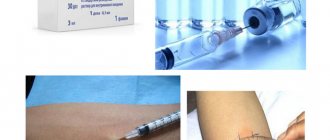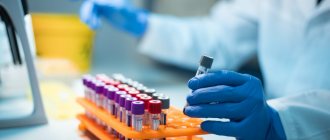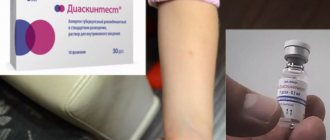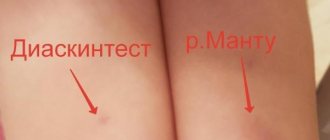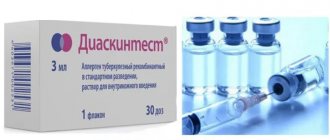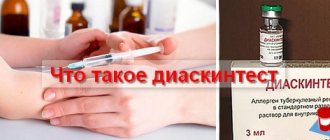Compound
It is worth immediately noting that the drug does not contain either live tuberculosis bacteria or their metabolic products.
The composition contains only antigens of synthetic origin, which, when they enter the human body, are recognized by the immune system as pathogens of the disease.
The diagnostic preparation also contains auxiliary components: saline solution, phenol, polysorbate, potassium phosphate and sodium. All these substances are included in the composition in small quantities and do not have a negative effect on the body.
Differences between DST and Mantoux
The Mantoux test preparation contains a natural antigen obtained from Koch bacilli.
Diaskintest contains two types of synthetic antigens.
The main difference: Mantoux reacts to any contact of the body with tuberculosis - a disease, infection that the body coped with on its own, BCG vaccination, etc. This in some cases leads to false positive results.
Diaskintest perceives only active mycobacterium tuberculosis; it does not respond to other strains of bacteria and the BCG vaccine. DST is often prescribed after the Mantoux test to clarify the result.
Diaskintest does not replace Mantoux, since it does not show tuberculosis at the earliest stage and will not confirm the presence of immunity after BCG. For an accurate diagnosis, tests must be combined.
Both drugs are safe: neither Mantoux nor DST can cause disease.
Timing and indications for Diaskintest
The main indication for conducting a diagnostic test is the detection of tuberculosis among the population under the age of 18 years. Diaskintest is a screening test. As a rule, the test is given annually to children from 8 to 17 years old, but other options are also possible:
- DST is indicated once every 6 months if the child has not been vaccinated with the BCG vaccine within the period established by the national calendar.
- Children aged 1 to 8 years can be tested only if tuberculosis is suspected as a result of a positive Mantoux test.
Statement of DST is possible no earlier than a month after acute infectious diseases or vaccination and 2 months after receiving a negative result. If the test is positive, a repeat test is allowed as soon as possible.
Mantoux test, Diaskintest, T-test: we understand the nuances
The incidence of tuberculosis in Siberia remains at a high level. At the same time, parents are increasingly refusing to perform Mantoux tests on their children, for various reasons. What alternative options are there today? How is Diaskintest different from Mantoux? Is it possible to do a T-test in Novosibirsk, and will TB doctors accept its result? The Sibmeda portal asked these questions to Elena Shilova, a TB doctor of the highest category.
– Elena Petrovna, how pressing is the problem of tuberculosis in the Novosibirsk region among the child population? How is the situation? What are the trends?
– The problem of tuberculosis incidence remains relevant, both among the adult population and among children and adolescents. Tuberculosis is a social disease, but this does not mean that only socially maladjusted people get sick. This means that the disease is widespread in society and affects all segments of the population, regardless of social status.
The incidence of tuberculosis in adults in the Novosibirsk region has been decreasing in recent years, but remains at a high level (97.7 per 100 thousand population) and exceeds the incidence in the Russian Federation by 1.8 times (53.3 thousand population).
The incidence of tuberculosis in children in our region also exceeds the all-Russian figure by 1.8 times: in the Novosibirsk region it is 21.1 per 100 thousand children, in the Russian Federation - 11.5 per 100 thousand children. The incidence rate among adolescents in the Novosibirsk region is 42.7 per 100 thousand, in the Russian Federation, on average, 23.9 thousand.
Therefore, despite the emerging trend towards a decrease in incidence, the situation with tuberculosis remains tense. And the children found themselves hostage to this unfavorable situation, since there are many people with tuberculosis in society, and the child inevitably, sooner or later, encounters a tuberculosis infection. One of the tasks in early detection of tuberculosis infection in children is to make this meeting the safest for the child.
– What system is currently used in the Russian Federation for diagnosing tuberculosis in children?
– There are several stages in identifying tuberculosis in children. Early detection of tuberculosis in children and adolescents is the detection of primary infection (“turn” of tuberculin tests), early tuberculosis intoxication, latent tuberculosis infection, that is, those conditions when a focus of tuberculosis has not yet formed in organs and tissues. There are no changes in radiographs yet, but there is only an immunological restructuring in response to the introduction of the tuberculosis pathogen into the body.
The second stage is timely detection: the focus of tuberculous inflammation has already formed, which is confirmed by changes in the x-ray, but it is small in size, delimited, there is no decay, there is no release of mycobacterium tuberculosis - these are the so-called “closed” forms of tuberculosis. Clinical manifestations are not expressed.
What follows is late detection. Tuberculosis inflammation in this case is widespread, changes on the x-ray are already pronounced, there may be decay, the release of mycobacterium tuberculosis, that is, “open” forms of tuberculosis. Clinical manifestations are already evident.
And finally, late detection of tuberculosis is said to occur when advanced forms of tuberculosis with gross irreversible changes in the lungs are detected.
Currently, preventive work on tuberculosis is based on early detection of tuberculosis, which is based on immunodiagnostics (Mantoux test with 2 TE and Diaskintest).
For early diagnosis of tuberculosis in children under 7 years old, the Mantoux test with 2 TU is used, from 8 years old - a test with Diaskintest.
– How effective is this system?
– The existing system for early detection of tuberculosis works effectively. The Mantoux test allows you to record an encounter with an infection and carry out measures to prevent tuberculosis, or identify limited forms of tuberculosis.
In the majority of children and adolescents, tuberculosis was detected using preventive methods, which include the Mantoux test, Diaskintest, and fluorography from the age of 15.
There are also cases when, when examining family members for a positive Mantoux test in a child, tuberculosis was detected in the parents.

– Traditionally, Mantoux’s reaction raises many questions among parents. How do professionals evaluate this type of diagnostics, its pros and cons, and effectiveness?
– The Mantoux test today remains the only method for detecting sensitization (sensitivity) of a child’s body to the causative agent of tuberculosis.
Moreover, this sensitivity appears only if the tuberculosis pathogen is present in the body: this occurs in two cases: BCG vaccination containing live weakened tuberculosis pathogens, and spontaneous infection with pathogenic Mycobacterium tuberculosis.
The disadvantage of the Mantoux test is that in young children (up to 3 years old) vaccinated with the BCG vaccine, it is difficult to distinguish a post-vaccination allergy (response to BCG) from an infectious allergy (response to an encounter with an infection). Also, in children with a history of allergies, the sample may be slightly larger.
However, it is important to understand: the Mantoux test is specific, that is, it will be positive only in those children who have the tuberculosis pathogen in their bodies. Worms, parasites, lamblia do not affect the formation of infiltrate in response to the Mantoux test! Using the Mantoux test, we do not detect worms, nor do we detect food allergies!
The Mantoux test is not a vaccination, it is a diagnostic test to detect the presence of sensitivity to the causative agent of tuberculosis, so what kind of effectiveness can we talk about? We can talk about informativeness, yes - the sample is informative.

– What rules for performing Mantoux must be followed to minimize the risks of an unreliable result?
– The Mantoux test is carried out once a year for those vaccinated with the BCG vaccine, and for those not vaccinated with the BCG vaccine – 2 times a year (once every 6 months). The test is performed only on healthy children. If the child was sick, then a month after recovery.
The concept of a “false Mantoux test result” does not exist. For children with a history of allergies, it is better to perform the Mantoux test against the background of preparation with any antihistamine according to the scheme 5 days before and 2 days after the test.
The Mantoux test is always carried out before preventive vaccinations, but if vaccination has been carried out, then a month after it.
When performing the Mantoux test, the drug (tuberculin) is administered strictly intradermally; a white papule, a “button,” forms at the injection site. Under no circumstances should the injection site be sealed, wrapped, or scratched! You can shower your baby, but don’t rub it. The Mantoux test is assessed after three days (72 hours).
– How to correctly evaluate the results of the Mantoux test?
– The result of the Mantoux test is assessed by the size of the papule at the site of tuberculin injection (injection). Not all of the redness is measured, but only the thickening - the brighter part. The concept of a “norm” for the Mantoux test does not exist; it is assessed individually for each child. Therefore, it is important to do the test regularly, annually.
In a child vaccinated with the BCG vaccine in the maternity hospital, at 1 year of age the Mantoux test should be positive (papule 5-11 mm). Then its size decreases, and by 5-7 years it becomes negative. This is called post-vaccination allergy, that is, a response to the BCG vaccination.
If the test was negative (injection mark, redness without compaction), and a year later it became positive (papule 5 mm or more), or instead of decreasing it increased by 6 mm, then we are talking about a “turn” of tuberculin tests. It occurs when the tuberculosis pathogen enters the body, that is, it indicates an encounter with a tuberculosis infection, but this does not mean that the child has contracted tuberculosis!
In a child who has not been vaccinated against tuberculosis, the Mantoux test should be negative, and the appearance of a positive Mantoux test (papule 5 mm or more) indicates infection with Mycobacterium tuberculosis.
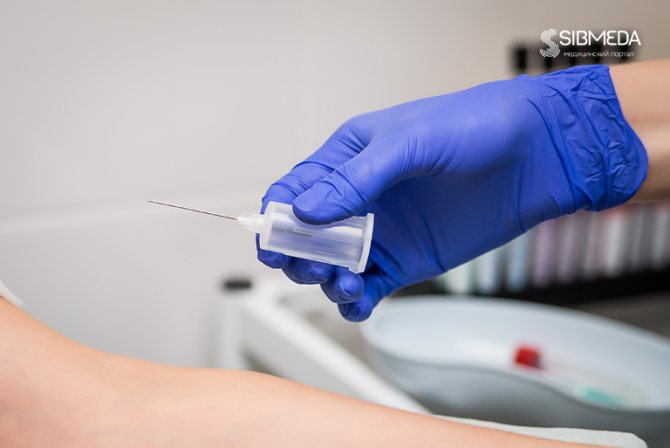
– If the Mantoux results are outside the normal range, how is further diagnosis made? What examinations should the child undergo?
– When a positive Mantoux test appears for the first time or when it increases, the purpose of further examination is to exclude the presence of tuberculosis and (or) prevent its development.
The pediatrician prescribes a general clinical examination (complete blood count, urinalysis) and a chest x-ray for the child. Parents and all family members over 15 years of age are required to have a fluorographic examination.
With the data from the examination, the child is referred to a phthisiatrician in order to exclude tuberculosis and, if necessary, to help the child cope with the infection.
The phthisiatrician prescribes a test with Diaskintest for the child: if the test result is negative, the child is left under observation for a year. Diaskitnest is repeated after 3-6-12 months. If it is doubtful or positive, additional examinations are prescribed in order to exclude the presence of tuberculosis. Computed tomography and ultrasound of internal organs are used.
If the presence of the disease is excluded, the child is prescribed preventive treatment for 3 months to prevent him from contracting tuberculosis. All this is done in the interests of the child.

– Can X-ray diagnostics be considered the most accurate method?
- No you can not. X-ray diagnostics, as a method of examining respiratory tuberculosis, is applicable only to adults and adolescents aged 15 years and older. This is due to the characteristics of the immune response to tuberculosis infection.
For a child, the most informative tests are Mantoux and (or) Diaskintest. When we find tuberculous changes in a child on an x-ray, we are already too late - this is a disease, and tests help us take timely measures and prevent tuberculosis.
– What new things are being introduced into the tuberculosis diagnostic system?
– In the diagnosis of tuberculosis infection in children, from the age of 8 it is currently recommended to use a test with Diaskintest.
An alternative method of testing for tuberculosis has recently appeared in Novosibirsk - this is the T-test (TV-spot).
PCR diagnostics and ELISA cannot be used as a preventive method of testing for tuberculosis.
– Does Diaskintest have any advantages over Mantoux?
– Diaskintest is no better or worse than the Mantoux test, it’s different. Three types of Mycobacterium tuberculosis may be present in a child’s body. The first is the BCG vaccine strain, which the child receives when vaccinated. The second is inactive pathogenic mycobacteria (L-form, they entered the body and the immune system dealt with them). And the third is pathogenic mycobacteria that are active, multiply and are ready to cause or have already caused tuberculosis.
In the presence of any of these pathogens, the Mantoux test will be positive, since it shows its presence in the body. But the test with Diaskintest will be positive only in those who have active, multiplying pathogenic mycobacterium tuberculosis.

At the same time, in children with a post-vaccination response to BCG and with inactive mycobacteria, the test with Diaskintest will be negative.
Thus, a test with Diaskintest allows us to identify a high-risk group for tuberculosis.
For example, we do a Mantoux test on a 1-year-old child in order to evaluate the effectiveness of BCG vaccination. It should be positive - and that's okay. And Diaskintest will be negative, therefore, there is no need for it.
– Is Diaskintest available to all children in Novosibirsk? Can parents choose it now as an alternative to Mantoux?
– Diaskintest for children under 7 years of age should be carried out only as prescribed by a TB doctor. Currently, it is carried out in anti-tuberculosis dispensaries. In Novosibirsk, in the general medical network, Diaskintest was carried out in 2021 for children from 14 years of age.
Diaskintest, of course, can be chosen as an alternative to the Mantoux test, but is it necessary? In order to answer, we need to decide what we need – a healthy child or a certificate.
– T-test (TV-spot, T-spot) blood test study – what does it involve? Is it done in Novosibirsk and do TB doctors accept the results?
– T-test is a determination of active tuberculosis infection, as with Diaskintest, using a blood test. Blood is taken from a vein.
In Novosibirsk, the T-test is done at the Novoklinik clinic and the Tuberculosis Research Institute. Phthisiatricians accept this test as a method of preventive examination for tuberculosis.
– If parents refuse Mantoux today, they are sent to a TB doctor to get a certificate. What tests and documents are required to obtain a certificate of absence of tuberculosis without Mantoux?
– In order to obtain a certificate from a phthisiatrician confirming the absence of tuberculosis without performing a Mantoux test, it is necessary to conduct one of the examinations: Diaskintest (T-test) or a chest x-ray, as well as a CBC, BAM and FLG of parents and all family members over 15- years old living in the same apartment.
Recommendations after testing
After conducting a diagnostic study until the results are monitored, it is recommended:
- Avoid intense workouts.
- Avoid prolonged contact with water.
- Limit walking in low temperatures.
- Do not expose the injection site to direct sunlight.
- Avoid mechanical external influences (do not scratch, touch, or rub the area where the drug is administered).
What to do if the sample itches?
A mild allergic reaction after an injection should not worry the patient. If your hand itches unbearably, severe itching occurs, the skin becomes covered with red spots, or the spot increases several hours after administration of the drug, you should be wary. This applies especially to children.
Doctors prohibit patients from scratching the injection site. In this case, the result will be interpreted incorrectly. Physical impact on Diaskintest provokes a change in a negative reaction to a positive one and vice versa. It is not recommended to take antihistamines within three days after the test.
Experts remind you what you should know about Diaskintest:
- Do not wet the injection site, wash it with soap, gel, or rub it with a washcloth;
- scratch it, even if severe itching occurs (this reaction is a deviation from the norm, tell your doctor about this);
- the test sometimes manifests itself only seven or ten days after it is carried out;
- if a person suffers from allergies, he should choose other methods for determining tuberculosis;
- a red mark after an injection may mean that the injection was given incorrectly, or indicate a pathology, especially if the redness does not subside for a long time;
- it is forbidden to mask redness with cosmetics, lubricate with ointments and medications that reduce inflammation (they can only be prescribed by a doctor);
- It is allowed to bandage the injection site with a bandage to minimize the impact on it.
If the sample itches unbearably, you can wipe the skin with a weak soda solution and apply a cool compress. If it is extremely important to obtain reliable results, you cannot influence Diaskintest. A few hours or the next day after the injection, spots appeared all over the body and weakness? In this case, call an ambulance immediately.
Decoding the results
Pediatricians and therapists evaluate the results of DST. There are three possible interpretations:
- Negative. This result indicates that there are no active tuberculosis bacteria in the patient’s body.
At the injection site, you can see a direct injection mark and a slight bruise.
- Positive. This result is characterized by the appearance of redness and infiltration at the injection site of the diagnostic drug.
A compaction of more than 15 mm may indicate an active infectious process in the body. In this situation, you should also pay attention to the lymph nodes, which may be inflamed and enlarged.
- Doubtful. Most often observed during the formation of a large bruise, when assessing the size of true hyperemia and infiltration is problematic. In such a situation, a repeat study is indicated.
Attention! When performing Diaskintest, false results are possible. Their causes are non-compliance with doctor’s recommendations, the development of an allergic reaction to the drug and the presence of autoimmune diseases in the patient.
Preparation and carrying out the procedure
Diaskintest is done only for absolutely healthy people. No special preparation is needed; for allergy sufferers, antihistamines are recommended a week before the procedure and several days after.
Alcohol is prohibited for adults three days before the test and before checking the results.
The drug is injected under the skin of the inner forearm.
A small white papule forms at the injection site.
Possible side effects are weakness, headache, slight fever. They are harmless and pass quickly.
DST does not provide for a strict requirement not to wet the injection site, but it is not advisable to do this. The injection mark cannot be rubbed, soaped, smeared with ointments and creams, sealed or bandaged.
Before assessing the test results (3 days), you should not sunbathe, overcool, or play sports, as sweat causes irritation at the injection site.
Contraindications to DST
Like any other diagnostic test, Diaskintest has a number of contraindications, namely:
- Skin diseases accompanied by widespread rashes.
- Acute infectious and inflammatory diseases.
- Severe chronic pathology in the stage of decompensation.
- Hyperthermia of unknown origin.
- Epilepsy.
- A number of mental illnesses.
- Hypersensitivity to substances included in the drug.
The list of contraindications can be increased by a specialist, based on the collected analysis and objective examination.
Diaskintest: general information
Diaskintest (DST) is a drug for conducting skin tests for tuberculosis, an analogue of the well-known Mantoux test.
This is not a vaccination, a DST is a test (like Mantoux); it is not a vaccine against tuberculosis, but only helps to detect it.
For adults, the main method for diagnosing tuberculosis is fluorography. Children are prohibited from doing it; they are given tests - tests for tuberculin, an extract isolated from mycobacterium tuberculosis. A positive test result means that the body is familiar with this substance, that is, it is infected or sick.
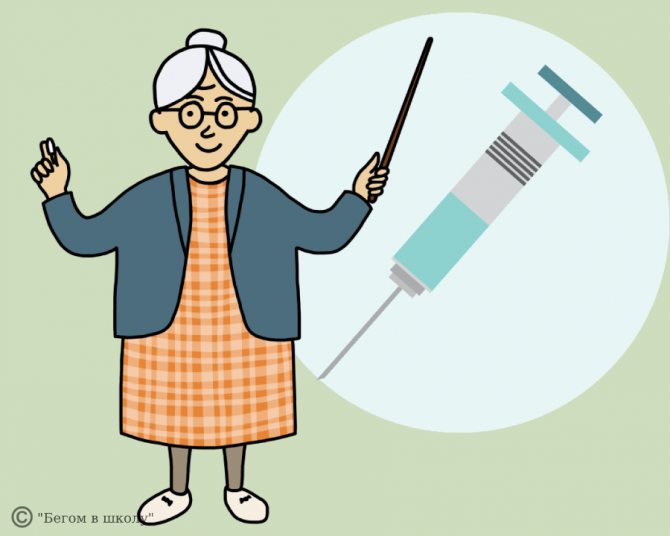
Adverse reactions
According to numerous patient reviews and scientific studies, the drug is well tolerated by the vast majority of those studied.
However, in approximately 1% of cases, undesirable reactions may develop in the form of a deterioration in general condition, dizziness, weakness, drowsiness, and increased body temperature. Allergic conditions may also develop, manifested by swelling, itching, hives, and shortness of breath. In severe cases, anaphylactic shock is possible.
The most rare side effect is a transient increase in blood pressure.
All undesirable manifestations usually disappear within a few hours or, less often, days. To relieve uncomfortable allergy symptoms, it is recommended to take antihistamines, for example, Erius.
Evaluation of results
The result is assessed after 72 hours. In some cases, the reaction appears earlier, but the most accurate test is after three days. Assess the size of the papule (swelling) and hyperemia (redness).
Negative result
The norm is a negative result: an injection mark and sometimes a bruise are noticeable at the injection site. There may be redness less than two mm in diameter.
This means that there is no tuberculosis in the body.
Please note: due to the bruise, the result is often considered doubtful, since it covers the redness.
Positive result
In what cases, depending on what is the DST vaccination positive?
A positive result—inflammation at the injection site—means the presence of tuberculosis bacilli in the body. The more there are, the stronger the reaction.
A positive reaction (swelling and redness) is possible:
- weak - less than 5 mm;
- moderate - 5-9 mm;
- pronounced - 10-14 mm;
- hyperergic - redness of 15 mm or more, with a crust and blisters.
A positive result is an indicator of inflammation, disease or infection. Infection does not necessarily lead to the development of tuberculosis.
If the immune system is strong, the body will cope with it on its own.
It is important to remember: one test (DST or Mantoux) does not make a diagnosis; further examination is necessary.
False positive result
Diaskintest gives a false positive result less often than Mantoux, in isolated cases.
Possible reasons:
- ignored or hidden contraindications (for example, asymptomatic infections);
- allergic reaction;
- infection at the injection site;
- autoimmune diseases.
How is Diaskintest performed?
When a test is prescribed for the first time, parents are often interested in the question of how Diaskintest is done. The procedure itself does not outwardly differ from the famous Mantoux production. The drug is injected intradermally into the middle part of the forearm using an insulin syringe. Only the needle point remains at the injection site. In some cases, a bruise may appear. Such options are the norm.
Diaskintest - preparation for analysis
The DST test can be performed at any time. Preliminary preparation, as for staging Mantoux, is not required. More often, the test is carried out in the morning, but there are no strict guidelines regarding the time of DST. Before the procedure, you are allowed to eat, as always, no special diets are required. In some cases, the test may be prescribed while other tests are being carried out; you should ask your doctor about the specifics of preparation for which.
Is it possible to wet Diaskintest?
This question arises because parents often draw a parallel between DST and Mantoux. In fact, these are two different research methods, each of which has its own characteristics. It is known that during the test, an infiltrate remains at the injection site. Its size determines the degree of the body's reaction to the introduced pathogen. With DST the situation is different.
The test leaves no traces behind (if the result is negative), so there is no need to avoid contact with water. Diaskintest can be wetted or washed, but do not rub the injection site too hard with a washcloth. Doctors also recommend refraining from visiting the pool after setting the DST. In some cases, the injection site may itch and itch, which is considered normal in the absence of other symptoms.
Diaskintest for adults
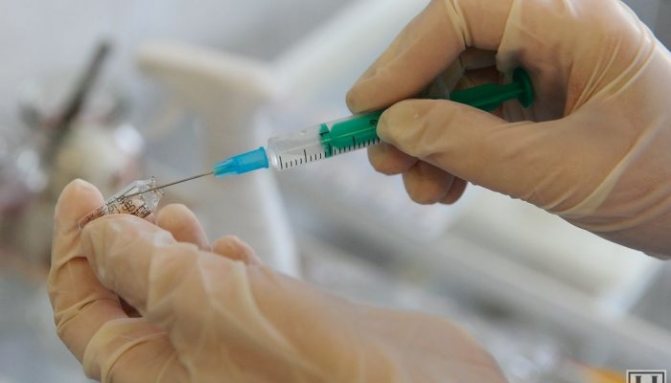
Most often, Diaskintest is performed to detect tuberculosis in school-age children, but sometimes this diagnostic method can also be recommended for adults. In particular, it is recommended to perform it as an additional research method for:
- Questionable fluorography results.
- Bad tests.
- The presence of specific symptoms (cough, inflammation of the lymph nodes).
- Constant contact with tuberculosis patients.
Diaskintest helps to make an accurate diagnosis, since if a papule appears on the body after the test is administered, it means that the body has recently been infected with Mycobacterium tuberculosis, or the disease is at an active stage of development.
Allergy
Some patients may be allergic to Diaskintest. This is due to the presence of a foreign protein in the drug used, which acts as an allergen. If there is any suspicion, you should first make sure that the patient does not have hypersensitivity to the components of this sample.
Are there or could there be other risks during the procedure? No, under normal circumstances Diaskintest has no consequences.
If the subject has an allergic reaction, it means that using this diagnostic method in the future is strictly prohibited.
In this case, symptoms such as:
- a slight jump in body temperature;
- headache;
- relative malaise;
are the body’s usual response to the procedure. Allergy to Diaskintest is more pronounced. If symptoms persist and the test site begins to itch, it is recommended to consult a specialist.
What to do if the reaction is positive?
If the Diaskintest result is positive, you should not panic, but trust the recommendations of an experienced doctor. Most often, doctors recommend:
- Pass general tests.
- Take an x-ray of the lungs.
- Conduct a CT scan (layer-by-layer x-rays).
- Conduct an ELISA test - an enzyme-linked immunosorbent diagnostic test, which is considered one of the most reliable and allows you to identify latent or extrapulmonary forms of the disease.
- Perform PCR. This study is considered the most accurate to date and allows us to detect DNA of Koch bacilli in various biological fluids of the body.
Patients with a positive Diaskintest are registered at a specialized tuberculosis dispensary. After all diagnostic procedures have been carried out, the diagnosis of tuberculosis is either confirmed or refuted. If necessary, a new Diaskintest can be performed over time, but only after 2 months.
How are the results assessed?
As a rule, the reaction occurs within 24 hours. After this time, it intensifies, and after five days it disappears. It is not recommended to evaluate the result on the first day. The best option for interpreting the result is three days.
Often patients complain that redness occurs on the first day or on the second day. You can’t ignore such a reaction, but you shouldn’t worry too much. After the examination, the doctor determines the injection site and makes a preliminary conclusion. The reaction can be negative, false positive and positive.
A TB doctor evaluates the results. What is normal and pathological?
- Absence of any reactions, slight change in skin color and thickening that does not cause discomfort.
- Extensive hematoma, severe swelling, bluish skin - all this requires additional examination of the patient.
- If the doctor doubts the results, repeat the Diaskintest over time.
- Measure the redness (papule) using a ruler. A positive reaction is indicated by a pronounced (10 mm) and strongly pronounced papule (15 mm). There is severe redness, swelling, and convexity of the injection point.
- An experienced doctor will be able to determine a positive reaction simply by looking at the sample. The same applies to questionable and negative results.
In any case, Diaskintest is not an exhaustive method for determining tuberculosis. Any results require confirmation. For example, an overly positive result is a hyperergic reaction to the test. This means that the patient’s body reacted too strongly to the administered drug. This reaction is not limited to the appearance of a red spot at the injection site, hematoma and swelling. Often the papule is larger than one centimeter in size, and there is inflammation around it.
Diaskintest is carried out only by a doctor or an experienced nurse who is authorized to carry out such a procedure. Sometimes the test causes a severe allergic reaction in the patient. This is not a side effect, since the drug contains a protein that is foreign to the body. Before administering it, it is advisable to make sure that the person is not sensitive to the components of Diaskintest.
